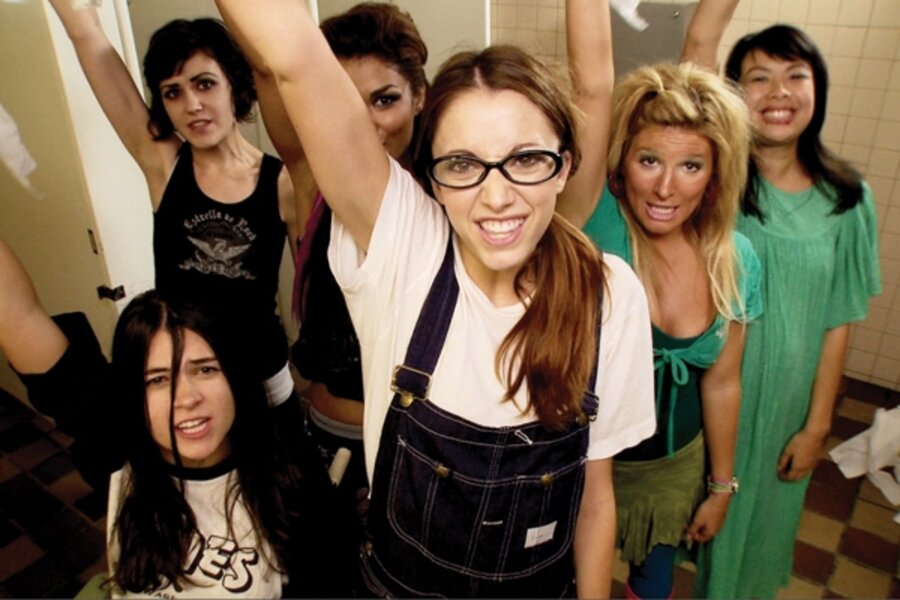What’s on Web TV?
Loading...
| Hollywood, Calif.
The scene outside the first Streamys – a new awards show for the best in original, episodic Web TV – a few weeks ago was a muddle, with a clogged red carpet and confusing entrances. Inside was little better, with overamplified and indistinct sound. But these ragtag production values belie a message being heard around this company town: serialized, high-quality video – longer than five minutes – is exploding across the “digisphere.” More important, perhaps, the movement is ushering in new story forms and techniques – shorter and more collaborative.
“It’s a paradigm shift,” says Chad Cooper, vice president of marketing, sales, and content at OVGuide, the online video search engine. Television network executives underestimated this market, he adds. “It’s still early but it’s happening faster than anyone expected.”
An Internet analyst, the Diffusion Group, predicts the serialized, longer form will account for nearly 70 percent of ad sales by 2013.
Of course, network TV is now streaming on sites such as hulu.com, TV.com and Joost.com. But the original, direct-to-the-Internet creations – beyond laughing babies and pet tricks – are, if not exactly coming of age, then reaching an important plateau of early adolescence. In slightly more than a year, websites with original “webisodic” material have grown from under two dozen to more than 100, according to OVGuide. A market that didn’t exist five years ago is becoming a serious Hollywood player.
“It’s what’s next,” says Richard Shore, head of content acquisition and production at digital studio RedLever. A film and TV veteran, Mr. Shore says he jumped into the new business because the new story techniques with faster character development and real-time fan feedback “excited” him. The distinction between old and new storytelling modes will begin to fade as early as year’s end, he adds, when the first wave of Internet-enabled TV sets begins to roll out.
This convergence, he says, will produce a single, much-expanded entertainment environment – all fueled by technology – better broadband connections, high-powered cellphones, and cheaper cameras and editing tools. But also in no small part by a bevy of professional writers who got a taste of the possibilities for episodic Web storytelling during the bitter 2007-08 writers’ strike.
“We are a confederacy of the tiny little islands of talent that have been popping up all over the Internet,” says Drew Baldwin, executive producer of the Streamys and a founding member of the International Academy of Web Television. “We want to raise the profile of this field by showing people the best.”
“We’re here to stay,” says Karen Harris, a Writers Guild of America board member who turned out at the Streamys in a show of support for Strike.TV, the Internet showcase founded last year after the labor walkout. The opportunities for talent are too rich to pass up, she says, pointing out that she owns her online show, “Life in General.” “Where else could I own my own show from the start?”
Twenty-three-year-old Taryn Southern, a Streamy nominee for a show she wrote, produced, and starred in, “Private High Musical,” agrees: “No way could someone at such an early stage in [his or her] career do all that and then get attention for that work.” To underline the point, she adds that “Musical” has been picked up as a pilot by MTV.
“This space is full of talent that has either been shut out by mainstream film and TV or who have something to prove,” says Jonathan Gray, assistant professor of communication and media studies at Fordham University in New York. “Many of them are going to help transform the way we tell stories and communicate with each other.” But the audience may need coaxing. “It’s going to take patience and some trust that this new medium is worth the time and attention.”
Big-name stars will help, says Mr. Gray, such as the first two Streamy winners: William Shatner and Neil Patrick Harris. And if self-promotion is any indication of maturity, then this Internet niche is well on its way. Besides the Streamys, four days earlier, “Harper’s Globe,” a new online drama from Eqal, threw a launch party at a Hollywood nightclub to celebrate the debut of the series – a pricey shindig usually held for films and premium television shows. The series has partnered with CBS and is designed to expand interest in the coming CBS series, “Harper’s Island.”
Creator Miles Beckett, who also conceived of and co-wrote “Lonelygirl15,” the 2006 Internet sensation, suggests this new material shouldn’t even be called television. “I call it a social show,” he says, “more about fostering dialogue and community.” Fans exchange e-mails and blog postings with the series’ characters. The weekly episode is then created from the exchange. “I see this as a new way of having a dialogue around information and entertainment,” he says. “This is more like the earliest days of story creation as a group effort. It’s just on a global scale.”
Shorter attention spans in a more mobile environment are hallmarks of the new storytelling, says Mark Avnet, professor of creative technology at the Virginia Commonwealth University Brandcenter in Richmond. But some values are being obscured, he says. “I worry that in the same way that the new portable music world with tiny headphones and mobile-phone speakers has trivialized and diminished music, the kind of deep storytelling experience that can only be had in a contemplative environment will be experienced less and less.”





